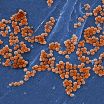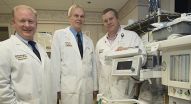Genome sequencing traces MRSA spread in high transmission setting
2014-12-09
(Press-News.org) December 9, 2014 -- Methicillin-resistant Staphylococcus aureus (MRSA) is a common cause of hospital-acquired infections, with the largest burden of infections occurring in under-resourced hospitals. While genome sequencing has previously been applied in well-resourced clinical settings to track the spread of MRSA, transmission dynamics in settings with more limited infection control is unknown. In a study published online today in Genome Research, researchers used genome sequencing to understand the spread of MRSA in a resource-limited hospital with high transmission rates.
Patients from two intensive care units (ICUs) in a hospital in northeast Thailand were tested over a three-month period for MRSA. During this time, 46 patients and 5 staff members tested positive at least once (16% adult and 34% pediatric patients). The genetic similarity of the MRSA isolates precluded the use of conventional low-resolution genotyping approaches for distinguishing transmission from one person to another. Therefore, whole genome sequencing was performed on a total of 76 patient isolates, including up to two repeat isolates from patients who tested positive for MRSA in the first screen. None of the patients or staff members that tested positive for MRSA had symptoms of an infection but rather were carriers.
"A striking feature of the phylogenetic tree based on S. aureus whole genome sequencing was the presence of multiple distinct clades," said senior author Sharon Peacock from the University of Cambridge and Wellcome Trust Sanger Institute. "This suggested that multiple clades of the same lineage were circulating in the hospital at the same time."
Examining single base changes in the genomes of MRSA isolates allowed researchers to infer the most likely transmission routes between infected patients. Transmission events were observed between patients within the ICU, and also between patients and staff members. These results are in contrast to a previous study performed in the UK where patient-to-patient MRSA transmission in the ICU was rare.
"Our long term goal is to use such information to inform infection control practice," said Peacock. "The degree of transmission we demonstrated in our study has directly led to the prioritization of improved hand hygiene practices at the study hospital."
Genome sequencing also revealed that MRSA clades were dynamic in the ICU over the three-month period, with some clades more prevalent early in the study and others later.
Deep sequencing of isolates taken from a single patient carrying MRSA for the longest period revealed that although all isolates were of the same clade, there were small genetic differences between them, suggesting bacterial diversity within a single carrier. This lends further support to previous work suggesting that understanding transmission networks will require measures of within-host bacterial diversity as well as traditional 'shoe-leather epidemiological' data.
INFORMATION:
Scientists from the University of Cambridge, Wellcome Trust Sanger
Institute, Menzies School of Health Research, Mahidol University, Public
Health England, and Imperial College London contributed to this study.
This work was supported by the Medical Research Council, Wellcome Trust,
and the Australian National Health and Medical Research Council. END
[Attachments] See images for this press release:

ELSE PRESS RELEASES FROM THIS DATE:
2014-12-09
SAN FRANCISCO (DECEMBER 9, 2014) -Common variations in four genes related to brain inflammation or cells' response to damage from oxidation may contribute to the problems with memory, learning and other cognitive functions seen in children treated for acute lymphoblastic leukemia (ALL), according to a study led by researchers from Boston Children's Hospital, The Children's Hospital at Montefiore, and Dana-Farber/Boston Children's Cancer and Blood Disorders Center.
The data, presented at the 56th annual meeting of the American Society of Hematology (abstract #856), suggest ...
2014-12-09
A team of Massachusetts General Hospital (MGH) investigators has identified what may be a biomarker predicting the development of the dangerous systemic infection sepsis in patients with serious burns. In their report in the open-access journal PLOS ONE, the researchers describe finding that the motion through a microfluidic device of the white blood cells called neutrophils is significantly altered two to three days before sepsis develops, a finding that may provide a critically needed method for early diagnosis.
"Neutrophils are the major white blood cell protecting ...
2014-12-09
Timing is key for brain cells controlling a complex motor activity like the singing of a bird, finds a new study published by PLOS Biology.
"You can learn much more about what a bird is singing by looking at the timing of neurons firing in its brain than by looking at the rate that they fire," says Sam Sober, a biologist at Emory University whose lab led the study. "Just a millisecond difference in the timing of a neuron's activity makes a difference in the sound that comes out of the bird's beak."
The findings are the first to suggest that fine-scale timing of neurons ...
2014-12-09
Researchers from the University of Cambridge have used genome sequencing to monitor how the spread of methicillin-resistant Staphylococcus aureus (MRSA) occurs in under-resourced hospitals. By pinpointing how and when MRSA was transmitted over a three-month period at a hospital in northeast Thailand, the researchers are hoping their results will support evidence-based policies around infection control.
MRSA is a common cause of hospital-acquired infections, with the largest burden of infections occurring in under-resourced hospitals in the developing world. Whereas genome ...
2014-12-09
The availability of a trace nutrient can cause genome-wide changes to how organisms encode proteins, report scientists from the University of Chicago in PLoS Biology on Dec. 9. The use of the nutrient - which is produced by bacteria and absorbed in the gut - appears to boost the speed and accuracy of protein production in specific ways.
"This is in some sense a 'you are what you eat' hypothesis,"' said senior study author D. Allan Drummond, PhD, assistant professor of biochemistry and molecular biology at the University of Chicago. "This nutrient that is absorbed through ...
2014-12-09
AUDIO:
Nitrous oxide, often called laughing gas, has been used in medicine and in dentistry for more than 150 years. But researchers at Washington University School of Medicine in St. Louis...
Click here for more information.
Nitrous oxide, or laughing gas, has shown early promise as a potential treatment for severe depression in patients whose symptoms don't respond to standard therapies. The pilot study, at Washington University School of Medicine in St. Louis, is believed to ...
2014-12-09
A new policy paper by a University of York academic calls for limits on the influence of the drinks industry in shaping alcohol policy because it has a 'fundamental conflict of interest'.
The article by Professor Jim McCambridge, of the Department of Health Sciences at York and academics at King's College London and the University of Newcastle, New South Wales, is published in this week's PLOS Medicine.
It says the concept of harm reduction has been co-opted by industry interests in public health debates about reducing the damage caused by alcohol. The paper argues ...
2014-12-09
Is being located next to a big-name competitor always bad for your small business? A new study in the Journal of Marketing Research shows that contrary to accepted belief, the presence of a large, nearby competitor can actually boost the sales of smaller brands.
"When the owner of Los Angeles's Coffee Bean & Tea Leaf could not stop Starbucks from moving in next door, he at first admitted defeat," note authors Neeru Paharia (Georgetown University), Jill Avery (Harvard University), and Anat Keinan (Harvard University). "However, soon after, he was surprised to see his sales ...
2014-12-09
LOS ANGELES (Dec. 09, 2014) - A computer system was more effective than doctors at collecting information about patient symptoms, producing reports that were more complete, organized and useful than narratives generated by physicians during office visits, according to a Cedars-Sinai study.
Investigators said the research, published in the American Journal of Gastroenterology, highlights the potential of computers to enhance the quality of medical care and improve outcomes by harnessing accurate and thorough patient information.
The authors said they did not expect ...
2014-12-09
PROVIDENCE, R.I. [Brown University] -- Harmful bacteria have evolved some ingenious mechanisms to resist antibiotics. One of those is the drug efflux pump -- proteins that stand guard along bacterial cell membranes, identifying antibacterial agents that pass through the membrane and swiftly ejecting them from the cell.
"These drug efflux pumps are extremely problematic," said Jason Sello, associate professor of chemistry at Brown University. "The drugs are pumped out of the bacteria and cannot reach the critical concentration for toxicity."
Sello and a team of researchers ...
LAST 30 PRESS RELEASES:
[Press-News.org] Genome sequencing traces MRSA spread in high transmission setting



